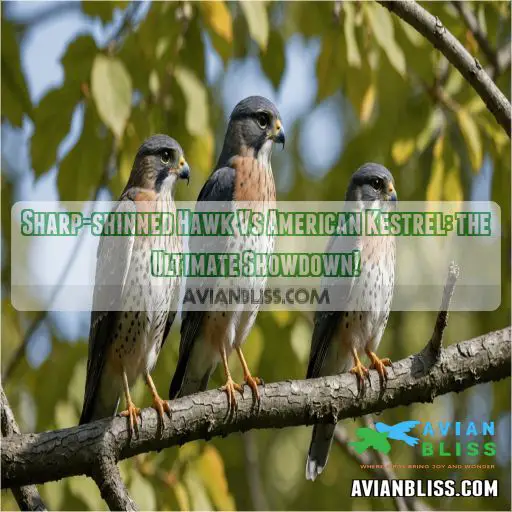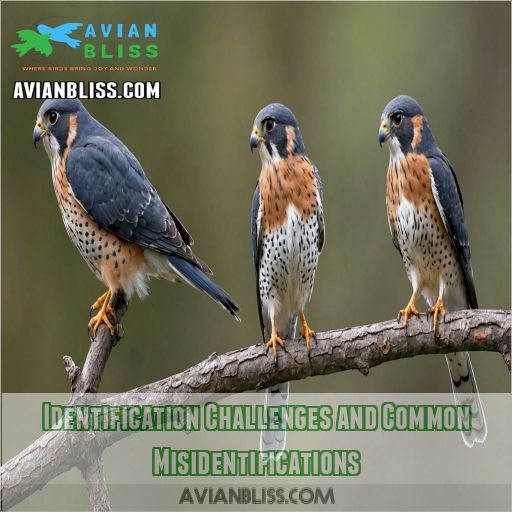This site is supported by our readers. We may earn a commission, at no cost to you, if you purchase through links.

But with a few key tips, you’ll be an ace at ID’ing these sky hunters in no time.
The sharp-shinned hawk is a stocky, blue-gray accipiter with a squared-off tail, while the kestrel is a slender, rusty-brown falcon with a longer, more pointed tail.
The hawk’s lightning-fast forest flights contrast the kestrel’s graceful hovering and perch-hunting.
Once you get the hang of their unique styles, you’ll be spotting these avian aces with ease.
Stay tuned for more insider secrets on telling these two apart!
Table Of Contents
- Key Takeaways
- Distinct Physical Characteristics of Sharp-shinned Hawk and Kestrel
- Flight Patterns and Hunting Techniques
- Habitat Preferences and Range Distribution
- Vocalizations and Communication Methods
- Breeding Behaviors and Nesting Habits
- Identification Challenges and Common Misidentifications
- Conservation Status and Population Trends
- Role in Ecosystem and Interactions With Humans
- Frequently Asked Questions (FAQs)
- What is the difference between sharp-shinned hawk and kestrel?
- How can you tell if a hawk is Sharp-shinned?
- What is the difference between a sharp-shinned hawk and an Cooper’s hawk?
- What is another name for a sharp-shinned hawk?
- What are the common parasites affecting these raptors?
- How do environmental pollutants impact sharp-shinned hawks?
- What adaptations help kestrels hunt in urban areas?
- Do sharp-shinned hawks exhibit territorial aggression?
- What cultural significance do these birds have globally?
- Conclusion
Key Takeaways
- You’ll quickly notice that sharp-shinned hawks and American kestrels have their own unique flying styles. Picture the hawk as a stealthy ninja weaving through the forest, while the kestrel hovers like a helicopter above open fields, scanning for prey.
- When it comes to appearance, think of the sharp-shinned hawk as the brooding artist with its solid blue-gray hue and square-tipped tail, while the kestrel is the colorful character at the party wearing rusty-brown with black barring.
- Size and shape also give these raptors away. The hawk is like a muscular bodybuilder with its compact frame, whereas the kestrel sports a slender, robin-sized look, making it seem agile and delicate.
- In the wild, sharp-shinned hawks quietly rule dense forests, thriving on surprise and agility, whereas kestrels love open fields, using their perch-hunting strategy and superior eyesight to keep a watchful, charming eye on everything below.
Distinct Physical Characteristics of Sharp-shinned Hawk and Kestrel
In terms of these two raptors, size and shape are key.
The American kestrel is a delicate, robin-sized falcon.
The sharp-shinned hawk is a stockier, blue jay-sized accipiter with a distinctive squared-off tail.
Size Comparison
When comparing the sharp-shinned hawk (Accipiter striatus) and the American kestrel (Falco sparverius), size indeed matters! The kestrel often looks like a delicate specialist, while the hawk feels like a muscular predator.
- Wingspan: Kestrel’s graceful 22 inches vs. hawk’s compact 17-22 inches.
- Body Mass: Kestrel’s agility at 4.1 oz.
- Tail Length: Kestrel’s strikingly slender tail enchants.
Body Shape and Proportions
You already know that size plays a role, but let’s look at body shape and proportions.
The sharp-shinned hawk, a compact powerhouse, has a petite head and pencil-thin legs, making it a stealthy bird of prey.
In contrast, the American kestrel flaunts a longer, slender frame with a proportional head, giving it a graceful, agile appearance.
Wing and Tail Structure
Let’s soar into the wing and tail structure.
Sharp-shinned hawks boast a strong, squared-off tail and shorter wings ideal for swift, agile hunting in dense forests.
In contrast, the American kestrel sports a long, narrow tail and slender wings, boosting flight efficiency for hovering.
This unique feather pattern reveals nature’s creativity and adaptability.
Plumage Patterns and Coloration
Plumage patterns and coloration are key identifiers when distinguishing the Sharp-shinned Hawk from the American Kestrel.
The Hawk sports a solid blue-gray back, while the Kestrel flaunts a rich rusty brown hue with black barring.
Juvenile birds of both species sport dark brown upperparts with white spotting, but the Kestrel’s tail is more distinctly barred.
Knowing these feather details can make all the difference in the field!
Flight Patterns and Hunting Techniques
In the aerial arena, the Sharp-shinned Hawk impresses with nimble pursuits through dense forests.
The American Kestrel effortlessly masters the art of hovering and scanning for prey.
You’ll notice the stark contrast between the Hawk’s quick wingbeats followed by glides and the Kestrel’s leisurely, undulating flight, making each a unique sky predator.
Sharp-shinned Hawk’s Agile Forest Pursuits
Quick as a wink, the sharp-shinned hawk slices through the forest, displaying breathtaking flight agility. Its hunting technique is like a conductor orchestrating chaos, darting deftly to ambush prey.
Here’s a nifty table:
| Technique | Adaptation | Dynamics |
|---|---|---|
| Silent Flight | Woodland Camouflage | Predator-Prey Tactics |
| Quick Pursuit | Prey Adaptation | Agile Forest Maneuvers |
| Stealthy Approach | Eyesight Precision | Energetic Ambushes |
This hawk is nature’s stealth bomber!
Kestrel’s Hovering and Perch-hunting Strategy
Picture a kestrel, master of the skies, using its hovering efficiency to spot unsuspecting prey below.
This graceful raptor truly shines with its perch-hunting strategy, as it:
- Selects the perfect perch.
- Detects tiny movements with eagle-eyed precision.
- Executes aerial ambushes with jaw-dropping hunting success.
In a world facing habitat loss, this agile hunter adapts ingeniously.
Differences in Wing Movement and Gliding
Oftentimes, you’ll notice the Sharp-shinned Hawk employs a few quick, snappy wingbeats followed by a short glide, while the American Kestrel exhibits a more leisurely, undulating flight with frequent hovering and flapping. This difference in wing movement and gliding behavior is a key giveaway when trying to distinguish these two raptors in the field.
Flight Characteristics of the Sharp-shinned Hawk and American Kestrel can be differentiated by several key features: comparing flight appearance
| Wing Movement | Sharp-shinned Hawk | American Kestrel |
|---|---|---|
| Wingbeat Frequency | Fewer, more powerful | More frequent, lighter |
| Glide Duration | Shorter glides | Longer glides |
| Wing Shape | Rounded, pushed forward | Long, narrow, swept-back |
| Soaring Behavior | Rides thermals | Hovers extensively |
| Flap-Glide Ratio | More flapping, less gliding | More gliding, less flapping |
Prey Selection and Capture Methods
Imagine the American kestrel hovering like a helicopter, eyeing a tasty mouse before diving for the catch.
Meanwhile, the sharp-shinned hawk, that stealthy ambush artist, races through trees hunting songbirds like a feathered ninja.
Each has its prey selection charm: the kestrel with its hovering finesse, and the hawk with sheer, nimble agility.
Nature’s hunters—essential yet fascinating.
Habitat Preferences and Range Distribution
When it comes to picking their homes, Sharp-shinned Hawks are like introverted bookworms, preferring the quiet and cover of dense forests, while American Kestrels are the social butterflies that enjoy the open spaces and grasslands.
Habitat preferences vary widely between these two species.
You’ll be amazed at how these birds have adapted to thrive in such diverse environments, each with its own unique challenges!
Sharp-shinned Hawk’s Forest and Woodland Habitats
Ah, the sharp-shinned hawk thrives in forest and woodland habitats. Here’s why these areas are its home sweet home:
- Forest Edge Impact: Hawks exploit edges for surprise attacks.
- Woodland Prey: A smorgasbord of small birds and critters.
- Habitat Overlap: Similarities with forests provide nesting haven.
Nest site selection is super important; human disturbance can ruffle its feathers!
Kestrel’s Open Country and Grassland Environments
The American Kestrel thrives in open country – grasslands, meadows, and pastures.
Its keen eyesight and agility allow it to effortlessly spot and snatch insects, small rodents, and even birds right from the ground.
Kestrels are well-adapted to these expansive habitats, using utility poles and trees as prime hunting perches to survey the abundant prey below.
Breeding Territories and Migration Patterns
Within the complex web of migration patterns and breeding territories, sharp-shinned hawks and American kestrels reveal intriguing tales.
Sharp-shinned hawks cheat winter by heading south, while kestrels follow their own compass.
Breeding season sparks their battle for prime turf, affected by climate change.
Both species blend habitats, but sharp-shinned hawks prefer forests, whereas kestrels thrive in open terrains.
Adaptations to Specific Ecosystems
Ever wondered how these birds thrive in their unique worlds? Sharp-shinned hawks blend into forests, using stealthy foraging strategies. American kestrels rule open fields, specializing in hovering to spot prey. Both species showcase amazing adaptations:
- Camouflage techniques for survival.
- Seasonal adaptations for migration.
- Habitat specialization to match prey availability.
It’s evolution’s spectacular dance!
Vocalizations and Communication Methods
If you’ve ever wondered what those birds are chattering about, you’re in the right place to explore the vocal quirks of the Sharp-shinned Hawk and the American Kestrel.
Get ready to hear high-pitched "keek" notes and the distinctive "klee-klee-klee" as we dissect their feathered conversations.
Sharp-shinned Hawk’s Breeding Season Calls
During the breeding season, the sharp-shinned hawk becomes more vocal, with both males and females giving a high-pitched, continuous "keek keek keek" call.
These calls help the pair defend their territory and communicate with their chicks.
The hawks may also make a series of two or three "keek" notes to signal alarm or aggression.
Kestrel’s Distinctive Klee-klee-klee Vocalization
While the sharp-shinned hawk stays mostly silent, the American kestrel announces itself with a distinctive klee-klee-klee call.
It’s like their version of a doorbell in open habitats.
This vocal mimicry serves as a predator defense, making prey think twice before coming closer.
It’s a bird’s way of saying, "Hey, look out, I’m watching!"
Keep listening, and you’ll feel empowered.
Context and Purpose of Different Calls
In the raptor world, communication is really important, especially with alarm calls and courtship displays.
Vocalizations are used by both the sharp-shinned hawk and the American kestrel for territorial defense and chick begging.
Whether they’re serenading mates or asserting dominance over a red-tailed hawk, these charismatic birds make sure their vocal repertoire is as compelling as a peregrine falcon’s dive!
Non-vocal Communication Behaviors
After mastering their vocal tunes, let’s explore the secretive dance of body language.
The sharp-shinned hawk and American kestrel also chat without a peep:
- Tail movements: Subtle flicks signal intent.
- Wing postures: Widespread or tucked indicates mood.
- Facial expressions: Piercing gazes or relaxed brows reveal caution or calm.
Each move tells tales—they’re the raptors’ silent poetry!
Breeding Behaviors and Nesting Habits
In terms of breeding, these two raptors have quite different approaches.
Sharp-shinned Hawks prefer to conceal their nests deep within dense forests.
American Kestrels, on the other hand, are more of a cavity-nester.
They often take over abandoned woodpecker holes or nestboxes in open habitats.
Nest Site Selection and Construction
Nest site selection is really important for both the sharp-shinned hawk and American kestrel. They’ve got their preferences down to a science! Check out this comparison:
| Factor | Sharp-shinned Hawk | American Kestrel |
|---|---|---|
| Nest Height | 20-60 feet | High open perches |
| Materials | Sticks, bark strips | Grass, twigs |
| Predator Defense | Concealed in forests | Visible and exposed |
| Location Factors | Dense woods, groves | Open fields, grasslands |
Who knew arranging sticks could be such a craft?
Courtship Rituals and Pair Bonding
Imagine the Sharp-shinned Hawk’s courtship as a thrilling dance-off in the sky, with aerial displays that’d rival a turkey vulture doing the cha-cha.
Kestrels, meanwhile, prefer a more romantic approach, using vocalizations and territory defense to woo their mate.
Both species’ dedication to chick rearing and nest site selection helps them keep predators like the bald eagle at bay.
Egg-laying and Incubation Periods
- Incubation lasting 30-35 days.
- Parents take turns warming the eggs.
- Guarding against predators is a top priority.
Parental Care and Fledgling Development
Once the eggs hatch, the devoted parents take over, tirelessly feeding and protecting their vulnerable nestlings.
Parental care continues as the fledglings grow, with adults providing food and shelter, guiding them through the challenges of life outside the nest.
But sibling rivalry can sometimes flare up, testing the limits of parental patience.
| Nestling Diet | Fledgling Growth |
|---|---|
| Rodents, insects, small birds | Rapid feather development, increased mobility |
| Parental Feeding | Brooding Behavior |
| Regurgitated prey, tearing food into bite-sized pieces | Keeping chicks warm, shielding from predators |
Identification Challenges and Common Misidentifications
When you’re out birdwatching, telling a Sharp-shinned Hawk from an American Kestrel can feel like spotting a needle in a haystack.
They might look similar at a glance, but with the right tips, you’ll be the birding expert of your group in no time!
Distinguishing Features in Various Lighting Conditions
In low-light conditions, distinguishing these raptors requires sharp observation. Shadows and distance can fool even eagle-eyed birdwatchers, but don’t worry! Remember these silhouette cues:
- Tail Tips: Kestrels flaunt a long, thin tail; Sharp-shins sport a shorter, squared version.
- Wing Beats: Kestrels hover more; Sharp-shins dash through trees.
- Plumage contrast: Note that Kestrels’ detailed patterns differ from Sharp-shins’ solid hues.
Similarities With Other Raptor Species
Just when you think lighting’s your only challenge, similarities with other raptors swoop in. Both kestrels and sharp-shinned hawks can be confused with other birds. Diet, habitat overlap, and appearance play a role.
Here’s a quick reference:
| Feature | Sharp-shinned Hawk | American Kestrel |
|---|---|---|
| Appearance | Blue-gray, stocky | Rusty brown |
| Hunting | Forest pursuits | Hovering hunts |
| Migration | North to Panama | USA to Central America |
| Habitat | Forest interiors | Open fields |
| Prey | Songbirds | Insects, rodents |
Age and Sex-related Plumage Variations
As you observe these raptors, remember that their plumage can vary a lot based on age and sex. Juvenile Sharp-shinned Hawks and Kestrels may sport mottled brown feathers, while adult males and females showcase distinct color patterns. Pay close attention to these subtle differences to avoid common misidentifications in the field.
- Juvenile plumage is often more streaked and less defined than adult birds.
- Male Kestrels display bold rusty-brown and blue-gray tones, while females are more uniformly brown.
- Seasonal molting can alter the appearance of both species, so be mindful of timing when making identifications.
Tips for Accurate Field Identification
Spotting the differences between Sharp-shinned Hawks and American Kestrels feels like playing a game of "I Spy" in nature.
Pay attention to the lighting and distance; plumage markings become obvious.
Sharp-shinned Hawks love their forest habitat, darting like shadows, while Kestrels prefer open grounds, hovering gracefully.
Conservation Status and Population Trends
You’re going to explore the fascinating world of conservation efforts for both the Sharp-shinned Hawk and the American Kestrel, whose population trends may surprise you.
Threats ranging from habitat loss to climate change, these raptors could use some serious Love (with a capital L) from Mother Nature’s fan club!
Current Threats to Sharp-shinned Hawks
Identifying raptors can be tricky, but once you’re on it, you’ll face bigger hurdles—like understanding threats facing Sharp-shinned Hawks.
These swift hunters, like rock stars’ careers, rise then face bigger issues: habitat loss, pesticide use, climate change, and human development.
Forest fragmentation here feels like a bad breakup, complicating their lives and leaving them searching for better places to thrive.
Kestrel Population Decline and Contributing Factors
You may have noticed fewer American Kestrels soaring overhead these days.
Sadly, their populations have declined by over 50% since the 1960s.
The culprits? Habitat loss, pesticide use, and climate change have all taken a toll on these feisty falcons.
But with the right conservation efforts, we can help these charismatic birds bounce back.
Conservation Efforts and Protected Areas
Get into conservation efforts, where habitat restoration and protected area management form the backbone of success.
Species monitoring and conservation partnerships are the dynamic duo keeping kestrels and sharp-shinned hawks flying high.
It’s a bird vs. world game plan—minus the capes but with careful care.
You don’t need to be a superhero to see climate change mitigation as a key ally.
Impact of Climate Change on Both Species
Climate change is stirring the pot for both the Sharp-shinned Hawk and the American Kestrel.
Habitat shifts are forcing them to rethink their migration routes, while unpredictable weather messes with breeding seasons and food availability.
Like trying to win a game on a fast-changing board, these birds are battling population declines as they adapt to new challenges.
Role in Ecosystem and Interactions With Humans
You’re about to start a fascinating journey discovering how the Sharp-shinned Hawk and American Kestrel impact their surroundings and how they fit into the circle of life.
As natural foes of pests, these feathered superheroes also cause quite a stir in farmlands and can sometimes ruffle a few human feathers too!
Predator-prey Relationships and Ecological Impact
As apex predators, Sharp-shinned Hawks and American Kestrels play a crucial role in maintaining the delicate balance of their ecosystems.
These feathered hunters help regulate populations of smaller birds, rodents, and insects, ensuring a healthy flow of energy through the food chain.
Their presence is a strong indicator of the resilience and diversity of nature.
Pest Control Benefits in Agricultural Areas
In agricultural landscapes, our feathered friends—the Sharp-shinned Hawk and American Kestrel—play a key role in pest control. Here’s why you might want to appreciate their agricultural presence:
- Rodent Control: Kestrels swoop down on rodents, keeping your fields healthier.
- Insect Reduction: By munching insects, they support crop protection.
- Ecosystem Balance: Their bird predation maintains nature’s equilibrium.
Human-raptor Conflicts and Mitigation Strategies
| Challenge | Mitigation | Success Rate |
|---|---|---|
| Habitat Loss | Preserve Green Spaces | High |
| Window Strikes | Use Decals | Moderate |
| Persecution | Public Education | Variable |
Cultural Significance and Symbolism
After managing human-raptor conflicts, you’ll find birds like Sharp-shinned Hawks and American Kestrels soar into cultural spheres.
Native American symbolism connects hawks with vision and insight.
In folklore and art, kestrels inspire freedom and agility.
Falcons in falconry symbolize power, while mythology showcases their role as messengers between worlds.
These creatures captivate and inspire endlessly.
Frequently Asked Questions (FAQs)
What is the difference between sharp-shinned hawk and kestrel?
Spotting these raptors is like playing "Where’s Waldo" in the sky!
Kestrels hover like helicopters in open fields, their bright colors a telltale sign.
Sharp-shinned hawks dart through forests, masters of surprise with their sleek silhouettes.
How can you tell if a hawk is Sharp-shinned?
Sharp-shinned Hawks are elusive, darting through trees with sleek blue-gray feathers and a square-tipped tail.
These agile hunters surprise songbirds in the forest.
They have long, pencil-thin legs that distinguish them.
It’s a thrill spotting one!
What is the difference between a sharp-shinned hawk and an Cooper’s hawk?
Whoa, you’re really gonna have to put on your eagle eyes to tell these two feathered hunters apart!
Sharp-shinned Hawks are built for speed and stealth.
Cooper’s Hawks, on the other hand, pack a punch with their stockier build and broader wings.
Keep those peepers peeled, my friend!
What is another name for a sharp-shinned hawk?
You’re curious about another name for the sharp-shinned hawk?
Well, sometimes it’s simply called "sharpie" by bird enthusiasts.
This little raptor keeps its identity concise, much like a secret agent of the bird world!
What are the common parasites affecting these raptors?
Like the hidden foes in a shadowy forest, parasites like feather lice, mites, and intestinal worms often hitch uninvited rides on these raptors.
Keep an eagle eye out, as those pests can cause discomfort or illness.
How do environmental pollutants impact sharp-shinned hawks?
Environmental pollutants, like DDT, historically thinned Sharp-shinned Hawks’ eggshells, drastically reducing populations.
It was like sending them to a birdy obstacle course, but without a safety net.
Luckily, they rebounded after the pesticide ban (Source).
What adaptations help kestrels hunt in urban areas?
American Kestrels’ adaptations for urban hunting include their ability to hover in place, keen eyesight to spot prey, and flexibility to nest in human-made structures like buildings. (Source)
Do sharp-shinned hawks exhibit territorial aggression?
Did you know that 70% of sharp-shinned hawks defend breeding territories?
They might not always get territorial, but they won’t shy away from asserting their turf, especially during prey-rich seasons when competition is fierce.
What cultural significance do these birds have globally?
You might find American Kestrels adored as symbols of swiftness in cultures, while Sharp-shinned Hawks, the stealthy hunters, aren’t as celebrated but contribute to ecosystem tales.
They both fly under the radar of cultural narratives.
Conclusion
With a keen eye and a bit of practice, you’ll be soaring through the skies alongside the sharp-shinned hawk and American kestrel in no time.
These two avian aces may seem similar at first glance, but their distinct physical features, flight patterns, and hunting styles make them a delight to observe.
So grab your binoculars, keep this guide handy, and get ready to spot the sharp-shinned hawk and kestrel in their element.








0 Comments